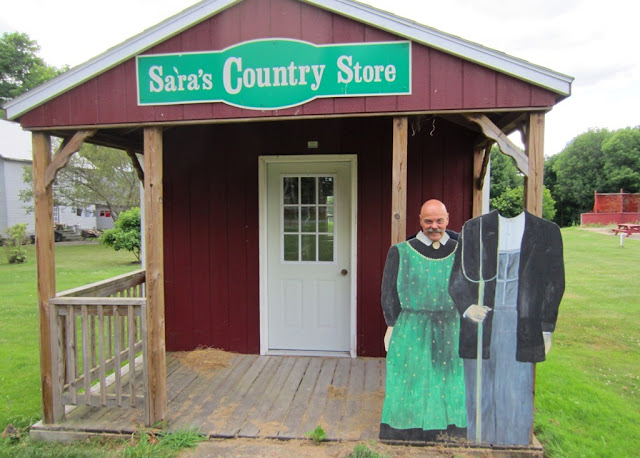The man tending the Hopkinton town museum on Sunday afternoon took me outside to see the two other exhibit spaces. There were exhibits inside this small building which looked interesting, but he discovered he had no key. I don't know who that ugly woman was with her headless husband:
And then he took me to the Museum Annex, a separate space filled with wonderful old memories from the town's past, especially farming implements, an old saddle and a horse drawn fire wagon:
That big, barrel shaped thing in the above photo was identified as a grain fanning mill. I have one of them in the hayloft of my barn which still has the original ornate paint and decorations. I wonder if the museum would like another:
I would never have figured this out if it weren't for the sign. It was a concrete block mold which produced, with much time and effort, one block at a time. I found this especially amazing because I sell concrete block for a living:
A very old washing machine and wringer:
A one row corn seed planter:
A horse drawn fire apparatus, apparently a hand pumper. I think that sign says it was last used in 1927 and it was no doubt quite outdated even then. I don't imagine it was really much help for putting out fires:
An antique grinding wheel for sharpening tools, knives, axes, etc:
I thanked the man who'd led me through the exhibits and left the museum just as a motorcyclist arrived to take a tour also. He, like me, said he'd been trying to find the museum open for a long time and was assured they'd stay open for him to see everything. Then I walked around the village green, looking at the other buildings such as the First Congregational Church:
The village green was shady and inviting, but no one was using it. It'd be buzzing with activity in another two weeks when the Hopkinton Summer Festival would be held:
The Town Court:
And this historical marker which said, "BRITISH RAID. In Feb.1814, British troops raided this village, seizing 300 barrels of flour of U.S. gov. and stored in barns of Col. Hopkins near brook."
I have read that the British soldiers took about half the flour, all they could carry in their sleighs, and about 20 firearms. Some muskets were saved by being hidden in beds where residents were pretending to be sleeping. It was noted that the soldiers were gentlemen in every way - except, of course, for taking the town's flour and firearms:













No comments:
Post a Comment
Note: Only a member of this blog may post a comment.